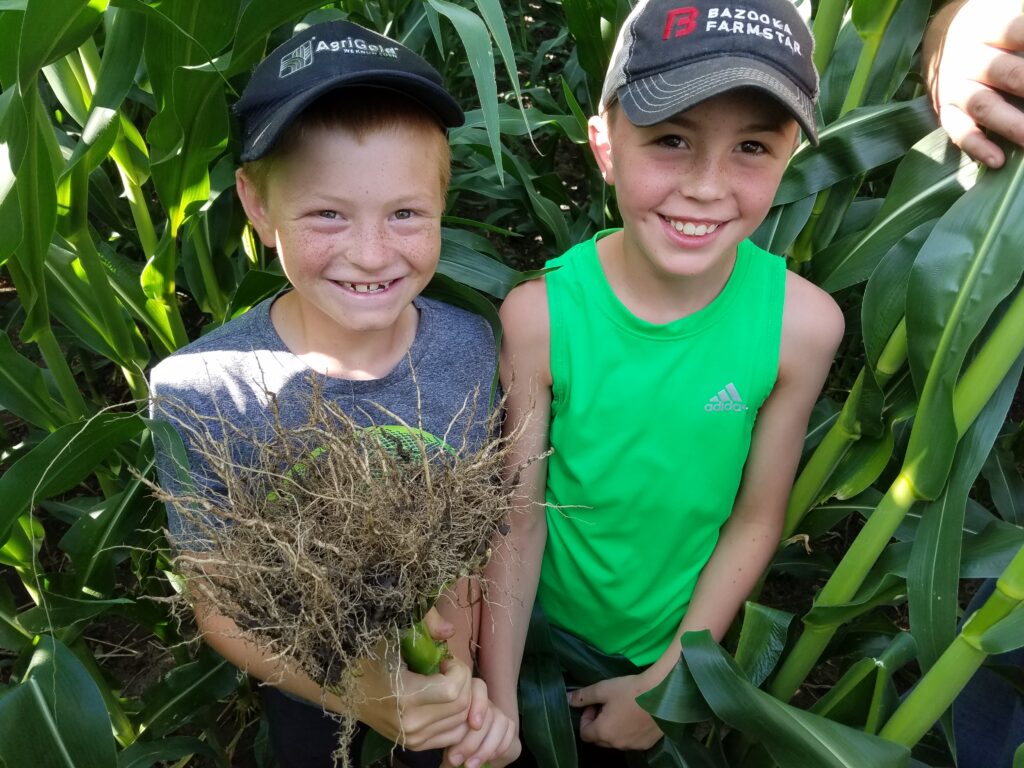Residue Management "Second Harvst"
Ohio Farmers Cut Fertilizer Bill, Boost Soil Health with Corn Residue Management
While modern corn hybrids’ double and triple-stack traits offer advantages, one big disadvantage is the residue after harvest.
“With the traits, nothing breaks down easily,” said Josh Knapke, 38, who farms with his brother Jeremy in West-Central Ohio near Rockford. “If you also plant cover crops, there’s a lot of material in the field by spring.”
It can take years for tough corn stover to decompose. “I’ve seen stalks lay out there for two and a half years or more,” said Knapke, a fourth generation farmer who raises corn, soybeans, wheat, hogs and cattle.
Simply slicing up corn residue and tilling it into the soil doesn’t speed up decomposition. Iowa State University (ISU) researchers have compared how fast Bt and non-Bt corn residue break down under conventional tillage, strip-till and no-till. Three years of field and laboratory trials at Ames, Iowa, involving tillage and residue found no differences in corn residue breakdown due to tillage or type of residue, said Mahdi Al-Kaisi, an ISU Extension soil scientist.
Instead, biological processes are responsible for residue breakdown, Al-Kaisi said. Knapke has observed the results of these biological processes in his hog barn’s manure pit.
“About eight years ago, our manure pit was foaming,” said Knapke, who tried Manure MasterTM FoamAway from ProfitProAG to get the foam under control. “The product relies on beneficial microbes, and it works.”
Since foaming is a microbial process, it’s vital to bring the biology back into balance in the manure pit. “It’s also important to bring biology back into the soil to break down crop residue efficiently, boost soil health and unlock nutrients in the residue to nourish next year’s crop,” says Dennis Klockenga, a crops specialist with ProfitProAG.
Why corn stalks don’t decay like they used to
Toughened corn stalks are often part of raising high-yielding corn with modern seed genetics. The slow decomposition of these “super stalks” can be a plus, because it slows the feeding of insect pests and provides a less-desirable environment for disease organisms that weaken stalks.
But these corn stalks just don’t decay fast enough in the field and can create headaches for farmers — especially those wanting to plant continuous corn, or those who are strict no-tillers.
Residue that doesn’t break down efficiently doesn’t flow as easily through planters and tillage equipment. A mat of residue won’t dry out and warm up in the spring, and the crop will suffer.
High grain yields have a lot of crop residue and if it isn’t digested biologically it decays and rots becoming a haven for pathogens and insects. That residue contains valuable nutrients that aren’t being utilized by next year’s crop. If the plant can utilize those nutrients, we can lower our fertilizer bill Klockenga noted. Sharp, tough residue can even damage farm equipment tires.
Four advantages of residue breakdown
There is a better way. Klockenga recommends a residue management program that relies on beneficial microbes applied once a year in the fall. When ProfitProAG’s blend of fungi and bacteria is sprayed on fields after harvest, the microbes break down tough cellulose and lignin in cornstalks. This helps the residue decompose easily, creates stable organic matter in the soil and provides other benefits.
“Residue digestion is a key part of ProfitProAG’s “Recipe for Success,”” said Klockenga, who noted that cost to spray the residue management product runs around $15 per acre. “When I was checking fields this past summer in Minnesota and Iowa, I saw good results where farmers were using our residue digestion program. The corn stalk residue turned black on the outside, and the pith was literally disintegrating.”
Klockenga also saw evidence of biological activity under the old corn roots. “There were many earthworms, the soil structure was aggregated, and the soil crumbled nicely.”
Here are four more reasons to put the residue breakdown portion of the “Recipe for Success” to work in your fields:
- Free fertilizer. Roughly 4 tons of corn residue per acre are left behind by a 180 bu/A corn crop. That material contains 80 pounds of nitrogen, 30 pounds of phosphorus, 190 pounds of potash, 16 pounds of sulfur, 35 pounds of calcium, and 25 pounds of magnesium. “These nutrients are free, if we can breakdown the residue biologically and release them to next year’s crop,” Klockenga said. “With the trend of increasing fertilizer prices, if we can release 190 lbs. of potash for next year’s crop, we can save that money and put it towards a cover crop and the crop residue digestion program.”
- Fewer pests and less disease. Corn residue is one of the best places for disease pathogens and insects to overwinter. By digesting the stover, the pests will have a difficult time surviving the winter without the protection of
the residue. - Less hair-pinning. Corn residue that hasn’t been broken down can get in the planter furrow. This can interfere with seed-to-soil contact. It can also hinder seed germination and emergence. When the residue is digested, it flows better through the planter and reduces hair pinning of the trash.
- More organic matter. Residue needs to be digested by fungi, bacteria and earthworms in order for it to be turned into organic matter. ProfitProAG’s program pre-digests the residue, allowing the microbes and earthworms to finish the job of creating organic matter.
Seeing is believing
The Knapke brothers were skeptical at first when Klockenga suggested the residue management system. “I was willing to try it, though, because I’d seen how well microbes worked with our manure management system,” Josh Knapke said.
Knapke sprayed ProfitProAG’s residue management product onto his fields following the 2020 harvest. He was shocked when he saw the results in the spring of 2021.
“There was no residue left,” said Knapke, who has some corn-on-corn acres. “When we did vertical tillage, the stalk residue just disintegrated.”
The product can be applied in the fall as long as outside air temperatures are in the 40’s during the day, Klockenga said. It can be used on all crop residue, including cornstalks, small grains, soybeans and more. “We recommend spraying the product with 15 gallons of water per acre to get good coverage,” he added.
Residue management is a key part of a new approach the Knapke brothers are taking to build soil health and boost yield potential, from eliminating ripping to adding more cover crops. The Knapke’s holistic system means they don’t use any commercial fertilizer, other than 28% UAN.
“To me, it’s not a hassle to spray the corn stubble before we put the sprayer away for the winter, especially when you consider all the benefits you’re getting,” Knapke said.
All this helps the Knapke family protect the most valuable asset on their farm – the soil. “If the soil isn’t healthy, the crops won’t be healthy,” Josh Knapke said. “We’re going to keep using ProfitProAG’s residue management program, because it’s worth it.”

Josh & Jeremy’s sons holding an impressive corn root
